Find aDomain Search Powered byGoDaddy.com ...
You might consider targeting a niche market by specializing in a certain aspect of your industry, such as guided jet ski trips.
We earn commissions if you shop through the links below. Read more
Written by: Carolyn Young
Carolyn Young has over 25 years of experience in business in various roles, including bank management, marketing management, and business education.
Published on February 1, 2022
Updated on October 6, 2022

Investment range
$13,550 - $47,600
Revenue potential
$150,000 - $450,000 p.a.
Time to build
1 – 3 months
Profit potential
$120,000 - $225,000 p.a.
Industry trend
Growing
Commitment
Flexible
If you’ve ever been on a jet ski, you know that there’s nothing like flying over the water with the wind blowing through your hair. Recreational boating is a big industry, worth nearly $30 billion, and jet skis are one of the more popular segments. That’s why personal watercraft sales increased 8% in 2020. You could start a jet ski rental business, grab a share of this growing market and give people joy while making a good living.
You can’t just jump into a jet ski business, however, like you zip across the water. Knowledge of the ins and outs of the business is necessary in order to be successful. Fortunately, this step-by-step guide has all you need to begin your entrepreneurial adventure.

Starting a jet ski rental business has pros and cons that you should consider before you decide if it’s right for you.
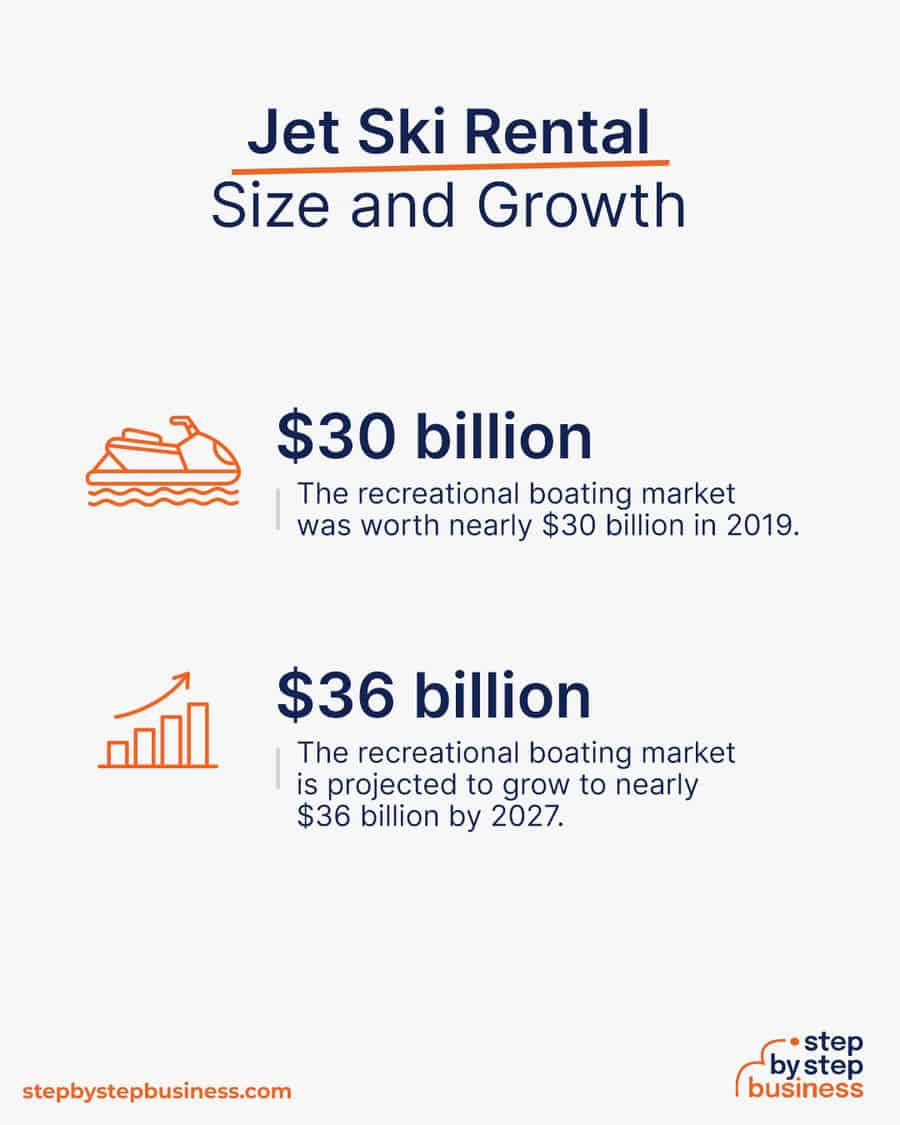
Trends in the jet ski rental industry include:
Challenges in the jet ski industry include:
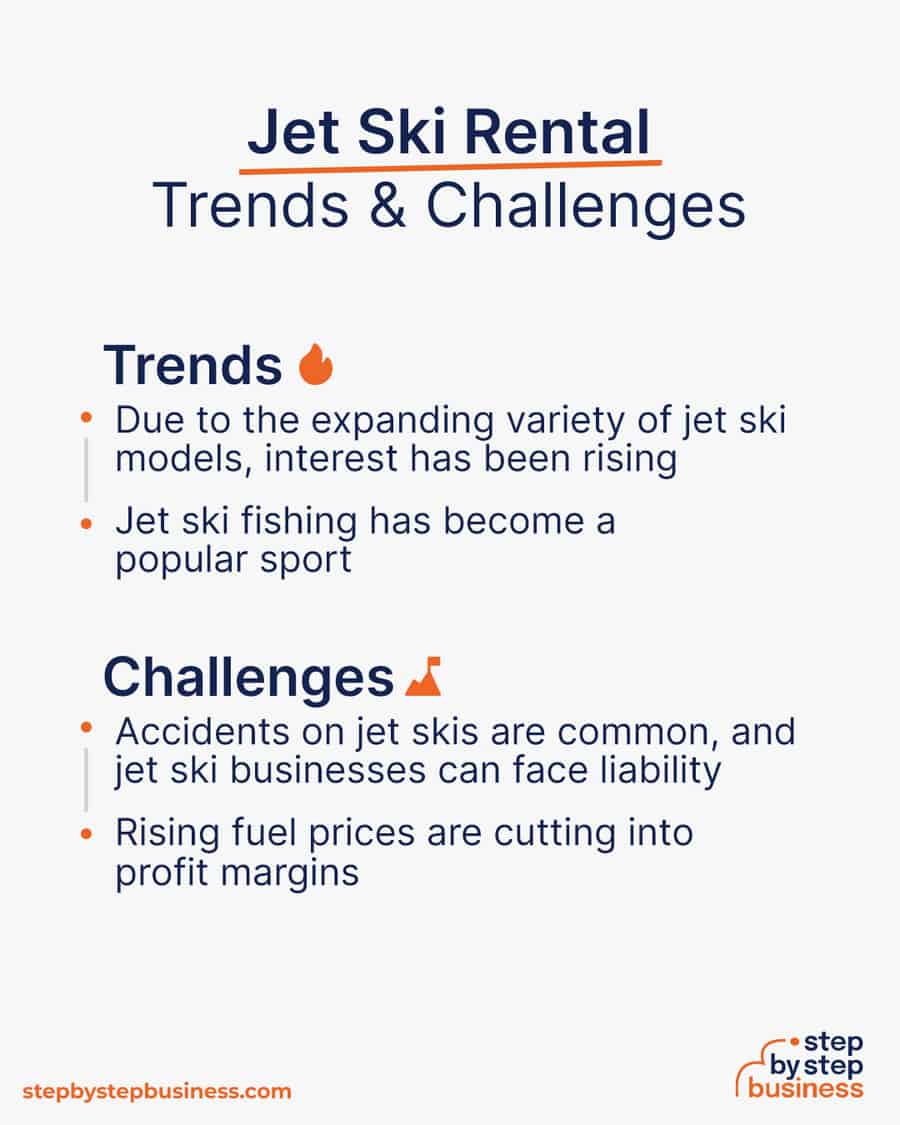
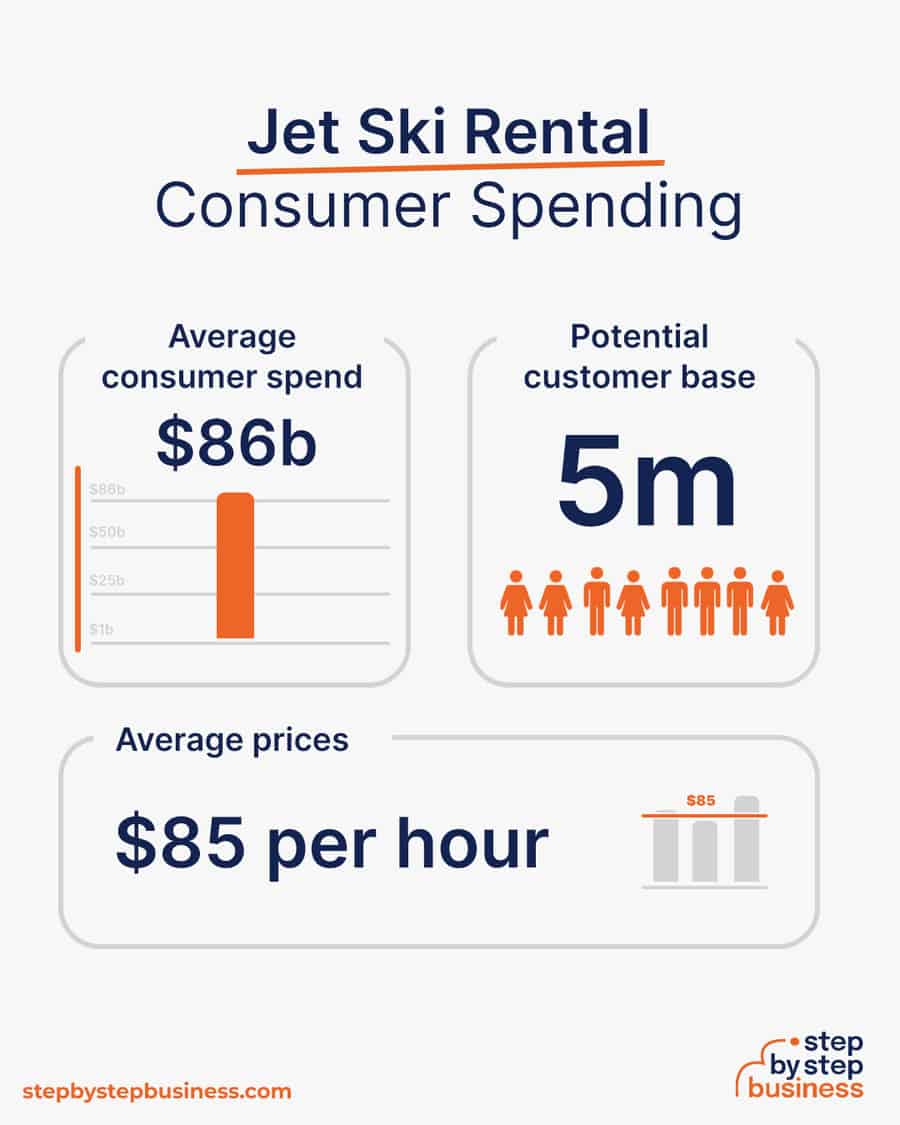
Startup costs for a jet ski rental business range from about $13,000 to nearly $50,000. The largest cost, of course, is the jet skis, so it depends on the quality of the jet skis you get and how many.
You’ll need a handful of items to successfully launch your jet ski business, including:
| Start-up Costs | Ballpark Range | Average |
|---|---|---|
| Setting up a business name and corporation | $150 - $200 | $175 |
| Business licenses and permits | $100 - $300 | $200 |
| Insurance | $100-$300 | $200 |
| Business cards and brochures | $200 - $300 | $250 |
| Website setup | $1,000 - $3,000 | $2,000 |
| Jet Skis | $10,000 - $40,000 | $25,000 |
| Life vests | $300 - $500 | $400 |
| Storage space rental | $200 - $1,000 | $600 |
| Trailer | $1,500 - $2,000 | $1,750 |
| Total | $13,550 - $47,600 | $30,575 |
The average price of a jet ski rental is $85 for one hour. Your profit margin after fuel and maintenance should be about 80%.
In your first year or two, you could rent two jet skis per day for 5 hours each for 175 days of the year, bringing in nearly $150,000 in annual revenue. This would give you nearly $120,000 in profit, assuming that 80% margin. As you grow your fleet of jet skis to 6, you might need an employee or two, reducing your profit margin to around 50%. With annual revenue of close to a whopping $450,000, you would make close to $225,000.
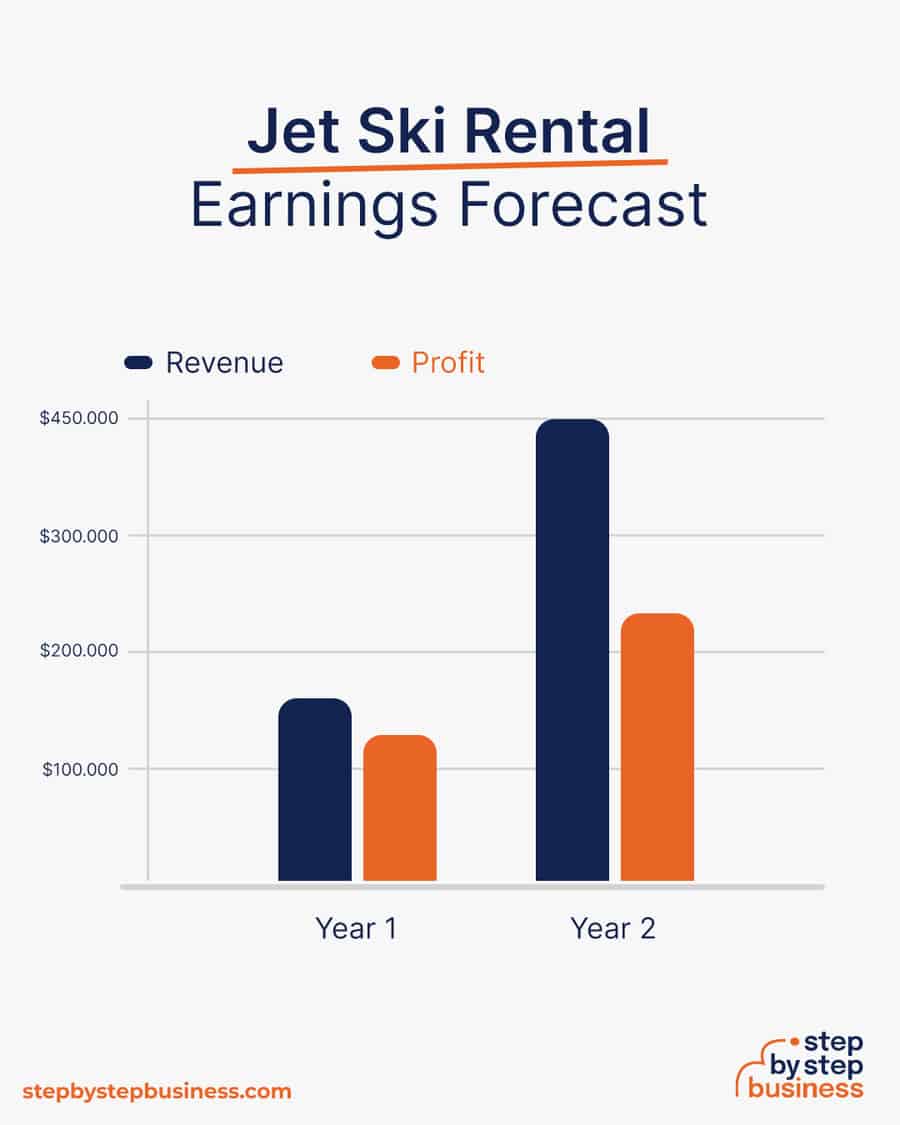
There are a few barriers to entry for a jet ski rental business. Your biggest challenges will be:

Now that you know what’s involved in starting a jet ski rental business, it’s a good idea to hone your concept in preparation to enter a competitive market.
Research jet ski rental businesses in your area to examine their services, price points, and customer reviews. You’re looking for a market gap to fill. For instance, maybe the local market is missing a jet ski fishing rental business.
You might consider targeting a niche market by specializing in a certain aspect of your industry, such as guided jet ski trips.
This could jumpstart your word-of-mouth marketing and attract clients right away.
You’ll want to determine if you want to add on any services to jet ski rental. You could add jet ski fishing, guided jet ski trips, or jet ski lessons.
Jet ski rental prices range from $70 to $100 for an average of $85. Your costs will be for fuel, maintenance, and storage of the jet skis. You should aim for a profit margin of about 80%
Once you know your costs, you can use this Step By Step profit margin calculator to determine your mark-up and final price point. Remember, the prices you use at launch should be subject to change if warranted by the market.
Your target market will be mainly tourists to your area. You can reach them on sites like Instagram and Facebook. You can also distribute flyers at local hotels, restaurants, or local attractions.
You only need storage space for your jet skis unless you want a physical structure on the water to rent your jet skis from. Find commercial space to rent in your area on sites such as Craigslist, Crexi, and Instant Offices.
When choosing a commercial space, you may want to follow these rules of thumb:
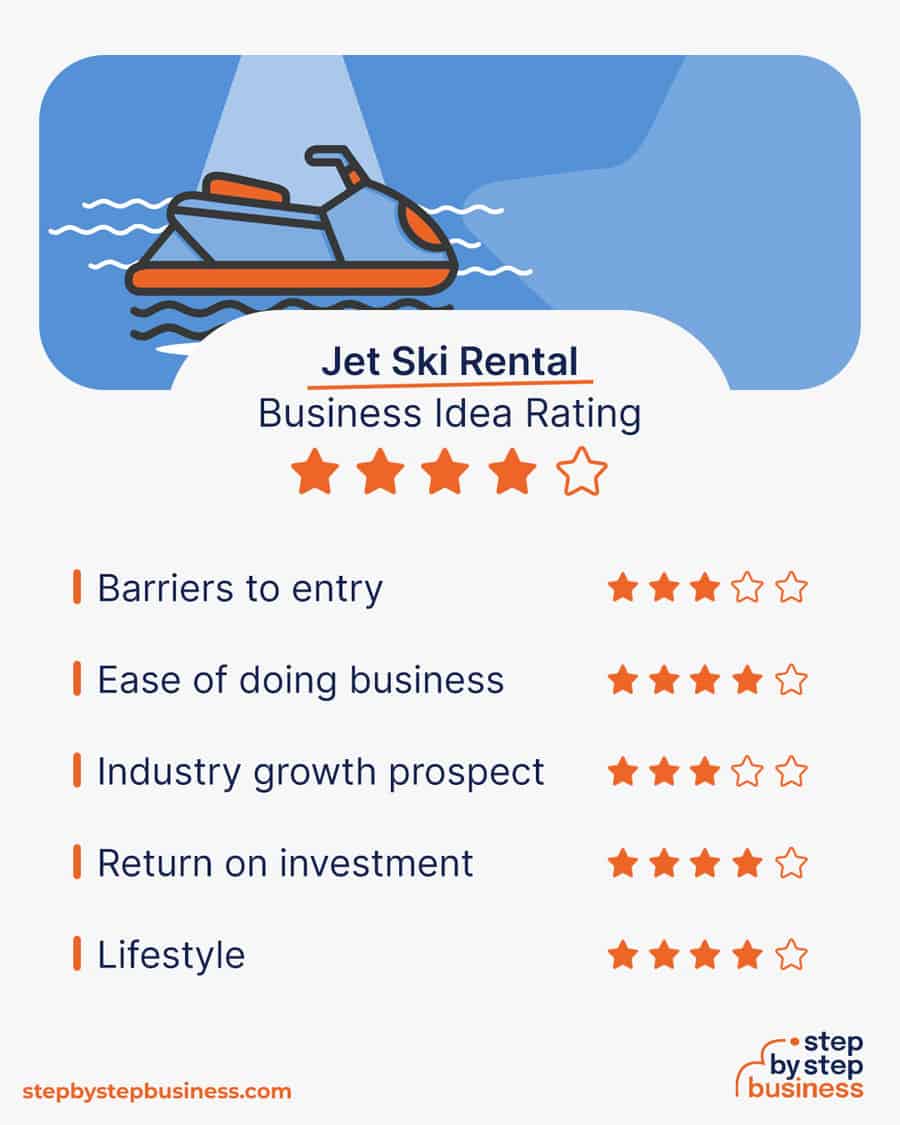

Your business name is your business identity, so choose one that encapsulates your objectives, services, and mission in just a few words. You probably want a name that’s short and easy to remember, since much of your business, and your initial business in particular, will come from word-of-mouth referrals.
Here are some ideas for brainstorming your business name:
Once you’ve got a list of potential names, visit the website of the US Patent and Trademark Office to make sure they are available for registration and check the availability of related domain names using our Domain Name Search tool. Using “.com” or “.org” sharply increases credibility, so it’s best to focus on these.
Finally, make your choice among the names that pass this screening and go ahead with domain registration and social media account creation. Your business name is one of the key differentiators that sets your business apart. Once you pick your company name, and start with the branding, it is hard to change the business name. Therefore, it’s important to carefully consider your choice before you start a business entity.
Every business needs a plan. This will function as a guidebook to take your startup through the launch process and maintain focus on your key goals. A business plan also enables potential partners and investors to better understand your company and its vision:
If you’ve never created a business plan, it can be an intimidating task. You might consider hiring a business plan specialist at Fiverr to create a top-notch business plan for you.

Registering your business is an absolutely crucial step — it’s the prerequisite to paying taxes, raising capital, opening a bank account, and other guideposts on the road to getting a business up and running.
Plus, registration is exciting because it makes the entire process official. Once it’s complete, you’ll have your own business!
Your business location is important because it can affect taxes, legal requirements, and revenue. Most people will register their business in the state where they live, but if you are planning to expand, you might consider looking elsewhere, as some states could offer real advantages when it comes to jet ski rental businesses.
If you’re willing to move, you could really maximize your business! Keep in mind, it’s relatively easy to transfer your business to another state.
Business entities come in several varieties, each with its pros and cons. The legal structure you choose for your jet ski rental business will shape your taxes, personal liability, and business registration requirements, so choose wisely.
Here are the main options:
We recommend that new business owners choose LLC as it offers liability protection and pass-through taxation while being simpler to form than a corporation. You can form an LLC in as little as five minutes using ZenBusiness’s online LLC formation service. They will check that your business name is available before filing, submit your articles of organization, and answer any questions you might have.

The final step before you’re able to pay taxes is getting an Employer Identification Number, or EIN. You can file for your EIN online or by mail or fax: visit the IRS website to learn more. Keep in mind, if you’ve chosen to be a sole proprietorship you can simply use your social security number as your EIN.
Once you have your EIN, you’ll need to choose your tax year. Financially speaking, your business will operate in a calendar year (January–December) or a fiscal year, a 12-month period that can start in any month. This will determine your tax cycle, while your business structure will determine which taxes you’ll pay.
The IRS website also offers a tax-payers checklist, and taxes can be filed online.
It is important to consult an accountant or other professional to help you with your taxes to ensure you are completing them correctly.
Securing financing is your next step and there are plenty of ways to raise capital:
Bank and SBA loans are probably the best option, other than friends and family, for funding a jet ski rental business.


Starting a jet ski rental business requires obtaining a number of licenses and permits from local, state, and federal governments. You’ll likely need a watercraft license. Check with your state for requirements.
Federal regulations, licenses, and permits associated with starting your business include doing business as (DBA), health licenses and permits from the Occupational Safety and Health Administration (OSHA), trademarks, copyrights, patents, and other intellectual properties, as well as industry-specific licenses and permits.
You may also need state-level and local county or city-based licenses and permits. The license requirements and how to obtain them vary, so check the websites of your state, city, and county governments or contact the appropriate person to learn more.
You could also check this SBA guide for your state’s requirements, but we recommend using MyCorporation’s Business License Compliance Package. They will research the exact forms you need for your business and state and provide them to ensure you’re fully compliant.
This is not a step to be taken lightly, as failing to comply with legal requirements can result in hefty penalties.
If you feel overwhelmed by this step or don’t know how to begin, it might be a good idea to hire a professional to help you check all the legal boxes.
Before you start making money, you’ll need a place to keep it, and that requires opening a bank account.
Keeping your business finances separate from your personal account makes it easy to file taxes and track your company’s income, so it’s worth doing even if you’re running your jet ski rental business as a sole proprietorship. Opening a business bank account is quite simple, and similar to opening a personal one. Most major banks offer accounts tailored for businesses — just inquire at your preferred bank to learn about their rates and features.
Banks vary in terms of offerings, so it’s a good idea to examine your options and select the best plan for you. Once you choose your bank, bring in your EIN (or Social Security Number if you decide on a sole proprietorship), articles of incorporation, and other legal documents and open your new account.
Business insurance is an area that often gets overlooked yet, especially for jet ski rental, it can be vital to your success as an entrepreneur. Insurance protects you from unexpected events that can have a devastating impact on your business.
Here are some types of insurance to consider:


As opening day nears, prepare for launch by reviewing and improving some key elements of your business.
Being an entrepreneur often means wearing many hats, from marketing to sales to accounting, which can be overwhelming. Fortunately, many websites and digital tools are available to help simplify many business tasks.
You may want to use industry-specific software, such as Alert, booqable, or Quipli, to manage your bookings, inventory, purchases, and payments.
Some of your business will come from the casual passerby or online visitors, but still, you should invest in digital marketing! Getting the word out is especially important for new businesses, as it’ll boost customer and brand awareness.
Once your website is up and running, link it to your social media accounts and vice versa. Social media is a great tool for promoting your business because you can create engaging posts that advertise your products:
Take advantage of your website, social media presence and real-life activities to increase awareness of your offerings and build your brand. Some suggestions include:
Website development is crucial because your site is your online presence and needs to convince prospective clients of your expertise and professionalism. They are unlikely to find your website, however, unless you follow Search Engine Optimization (SEO) practices. These are steps that help pages rank higher in the results of top search engines like Google.
You can create your own website using services like WordPress, Wix, or Squarespace. This route is very affordable, but figuring out how to build a website can be time-consuming. If you lack tech-savvy, you can hire a web designer or developer to create a custom website for your business.
Unique selling propositions, or USPs, are the characteristics of a product or service that sets it apart from the competition. Customers today are inundated with buying options, so you’ll have a real advantage if they are able to quickly grasp how your jet ski rental business meets their needs or wishes. It’s wise to do all you can to ensure your USPs stand out on your website and in your marketing and promotional materials, stimulating buyer desire.
Global pizza chain Domino’s is renowned for its USP: “Hot pizza in 30 minutes or less, guaranteed.” Signature USPs for your jet ski rental business could be:

You may not like to network or use personal connections for business gain. But your personal and professional networks likely offer considerable untapped business potential. Maybe that Facebook friend you met in college is now running a jet ski business, or a LinkedIn contact of yours is connected to dozens of potential clients. Maybe your cousin or neighbor has been working in jet ski rentals for years and can offer invaluable insight and industry connections.
The possibilities are endless, so it’s a good idea to review your personal and professional networks and reach out to those with possible links to or interest in jet ski rentals. You’ll probably generate new customers or find companies with which you could establish a partnership.

You may not need any employees at first, but eventually you may want to hire assistants to help you with the jet ski rentals.
Free-of-charge methods to recruit employees include posting ads on popular platforms such as LinkedIn, Facebook, or Jobs.com. You might also consider a premium recruitment option, such as advertising on Indeed, Glassdoor, or ZipRecruiter. Further, if you have the resources, you could consider hiring a recruitment agency to help you find talent.

A jet ski rental business offers a great lifestyle, working on the water, enjoying the sunshine and helping people enjoy their free time. What could be better? People love being out on the water, with the recreational boating industry coming in at $30 billion.
It will take a bit of an investment to start your business, but the many rewards, including a hefty wad of cash in your pocket, will be worth it. Now that you understand the business side of jet ski rentals, get ready to zoom your way to becoming a jet ski entrepreneur!
You can start a jet ski rental business for about $13,000. That would get you started with 2 jet skis, and later you could add more to your fleet.
You can rent jet skis for about $70 to $100 per hour, so even if you only have two jet skis, you can make up to $1,000 per day. Even if you’re only working half the year due to the weather, you can bring in some nice money.
You will probably need a watercraft license, and you may need various other licenses and permits at the state and local levels. Check with your local governments for requirements or visit MyCorporation’s Business License Compliance page.
You can charge between $70 to $100 per hour for rentals. You could also earn additional revenue by offering jet ski fishing or doing guided tours on jet skis. You could also offer jet ski lessons.

Published on August 16, 2023
Find aDomain Search Powered byGoDaddy.com ...
Read Now

Published on March 16, 2023
Lorem ipsum dolor sit amet, consectetur adipiscing elit, sed do eiusmod tempor incididunt ut labore et dolore magna aliqua. Ut enim ad minim veniam, ...
Read Now

Published on March 10, 2023
When to Use Paychex Flex When to Use QuickBooks Payroll ...
Read Now
No thanks, I don't want to stay up to date on industry trends and news.
Comments